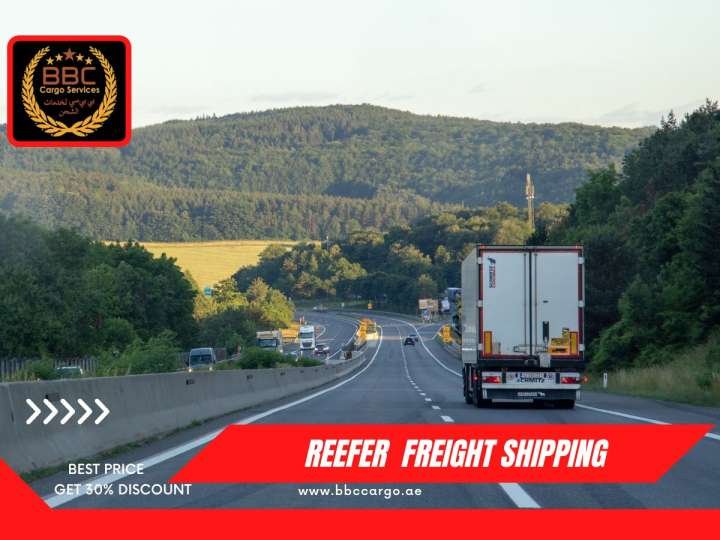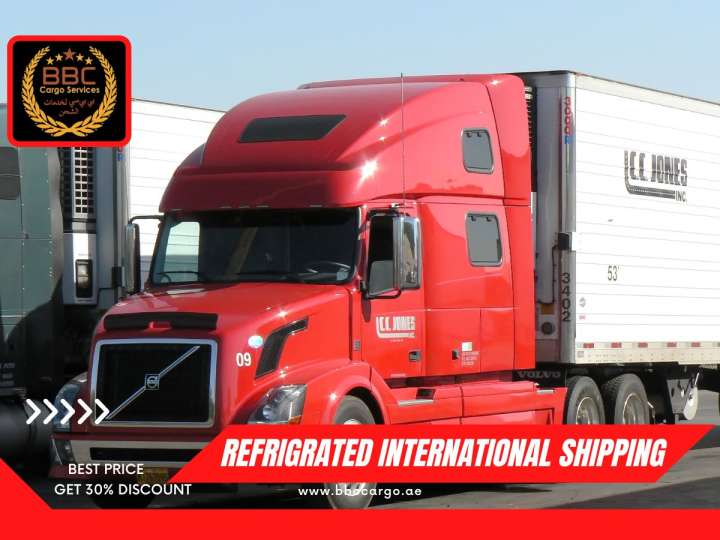Freight Forwarders Frozen Food Shipping Refrigerated Truck from Dubai:
BBC Freight Forwarding Industry has special depart for frozen food items like Dates, Milk, Eggs, Chocolate, Ice, Vegetables, Fish, Meat, frozen chicken, and fruits delivered by refrigerated truck from Dubai to Oman, Saudi Arabia, Qatar, Bahrain, and Kuwait.
In this three-part series on shipping frozen food Shipping, we will cover the inputs and outputs and best practices one must consider when BBC shipping frozen food in order to stay compliant with the FDA’s Food Safety Modernization Act (FSMA).
we will cover the temperature best practices from origination to destination, sanitary provisions, and traceability of food and technology around traceability.
Food tractability when Shipping Frozen Food
- Produce (Food) Traceability Initiative (PTI) to enhance traceability throughout the Food Supply Chain.
- Solutions to marking cases and pallets to meet PTI requirements.
- Steps to achieve traceability: Labeling and coding solutions: Laser coding and printer applications.
- Includes a Global Trade Identification Number (GTIN) for traceability of food en route to the customer overseas.
- Many other food companies are part of this initiative.
- Each 3PL or Supplier that consolidates frozen food should have traceability software and labels available to meet the PTI.
Shipping Frozen Food
The Ins, Outs, and Wherewithal In this three-part series on Shipping Frozen Food freight, we will cover the ins and outs and best practices one must consider when shipping frozen food in order to stay compliant with the FDA’s Food Safety Modernization Act (FSMA).
In this post, we will cover the temperature best practices from origination to destination, sanitary provisions, and traceability of food and technology around traceability.
How to transport frozen food?
Please let us know in the comment section at the end, your thoughts and additions to the below when shipping frozen food.
When it comes to frozen food, this is often referred to as the Cold Chain. A cold chain is a temperature-controlled supply chain, according to Wikipedia.
Temperatures for cold supply chain
The required temperature is the responsibility of the exporter depending on the type of frozen food. However, the customer may have temperature specifications as part of their purchase order/agreement.
Shipping Frozen Food General
All frozen food must be held at an air temperature of 0 degrees F; the internal product temperature should not exceed 10 degrees F. Vehicles should be pre-cooled to an air temperature of 20 degrees F, or lower before loading.
Frozen food shipments will not be accepted for transportation when the internal product temperature exceeds 0 degrees.
The most common temperature standards are “banana” (13 degrees C), “Chill” (2 degrees C) and “Frozen” (-18 degrees C), and “Deep Frozen” (-29 degrees C).
Staying within these temperatures is vital to the integrity of a shipment along the cold supply chain and for perishables, it enables optimal shelf life. Any divergence can result in irrevocable and expensive damage.
The major cold chain technologies involve
Dry ice, gel packs, plates (filled with liquids and can be used many times), liquid nitrogen quilts (insulated pieces that are placed over and around the freight to act as a buffer in temperature variations and to maintain the temperature relatively constant and reefers (temperature-controlled container or truck).
The “last mile”: A shipment going to its destination. Trucks and vans, the primary modes of transportation for this stage, must meet the specifications necessary to transfer the cold chain transportation for this stage.
Also important is the final transfer of the shipment into the storage facilities, as there is potential for a breach of temperature integrity.
The forwarder advises the carrier of the ocean freight container on the requested temperature setting at the time of booking the freight. Prior to loading, the shipping line (or trucker) will pre-trip the reefer container.
Refrigerated International Shipping from UAE to all Gulf Countries
Refrigerated International Shipping Services by road freight process on the time. If we ship frozen food or like vegetables, Meat, or Eggs so we need to ship on the time otherwise all food items may be irrevocable and have expensive damage.

Frozen Chicken daily base freight from UAE to all Gulf Countries Which areas we cover in UAE and also other Countries.
All UAE States for Refrigerated Truck available for shipping any freeze freight from Dubai, Abu Dhabi, Ajman, Sharjah, Al ain, Ras Al Khaimah, Fujairah, and Um al Quwain.
- Frozen Food shipping from Dubai to Qatar
- Refrigerated freight from UAE to Oman
- Cold Ice, Milk, eggs, dates, and frozen chicken, fish shipping from Dubai to Kuwait
- frozen shipping company transport from UAE to Saudi Arabia, KSA
- Reefer shipping for frozen fish from Dubai to Bahrain and Bahrain to Dubai.
- Chiller Cargo services shipping reefer containers worldwide.
- Refrigerated truck or trailer or transport any temperature required will be set on customer demand.
The reefer person will turn on and set the container to the proper temperature setting required by the exporter so that when it shows up for loading on the ocean vessel it will be at the exact temperature.
The shipping line has a meter that records the proper temperature during the duration of the trip. You receive a readout from this meter with constant temperature graphs.
Carriers offer “protected” services at the port. For a fee, the container yard /port/terminal will send a person out to check the fuel level of the reefer container and its functionality just to ensure nothing is wrong.
Sanitary Provisions when Shipping Frozen Food
All internal surfaces of vehicles and devices used for transporting frozen food shall be clean and free of objectionable odors before being loading with frozen food. shipping frozen food freight
Combination of RFID and TRACEABILITY when Shipping Frozen Food
- There is technology available to combine an RFID tag for Identification/traceability and temperature control.
- The RFID with a temperature indicator tag is a microchip combined with an antenna in a compact package.
- The packing is structured to allow the RFID tag to be attached to an object to be tracked. It also incorporates memory, a battery, and a clock to record sensor data in memory at constant intervals.
- The 3PL and/or the Supplier may have this technology available.
- 3PLs are combining GPS and temp tags.
In the next part of this series about shipping frozen food freight, we will cover Quality Specifications and export documentation.
Remember, if you have any thoughts, please let us know below!
Temperatures for cold supply chain:
- The required temperature is the responsibility of the exporter depending on the type of frozen food. However, the customer may have temperature specifications as part of their purchase order/agreement.
- Shipping Frozen Food General: All frozen food must be held at an air temperature of 0 degrees F; the internal product temperature should not exceed 10 degrees F.
- Vehicles should be pre-cooled to an air temperature of 20 degrees F, or lower before loading. Frozen food shipments will not be accepted for transportation when the internal product temperature exceeds 0 degrees.
- The most common temperature standards are “banana” (13 degrees C), “Chill” (2 degrees C) and “Frozen” (-18 degrees C), and “Deep Frozen” (-29 degrees C).
- Staying within these temperatures is vital to the integrity of a shipment along the cold supply chain and for perishables, it enables optimal shelf life. Any divergence can result in irrevocable and expensive damage (liability section).
- The major cold chain technologies involve dry ice, gel packs, plates (filled with liquids and can be used many times), liquid nitrogen quilts (insulated pieces that are placed over and around the freight to act as a buffer in temperature variations and to maintain the temperature relatively constant and reefers (temperature-controlled container or truck).
- The “last mile”: A shipment going to its destination. Trucks and vans, the primary modes of transportation for this stage, must meet the specifications necessary to transfer the cold chain transportation for this stage.
- Also important is the final transfer of the shipment into the storage facilities, as there is potential for a breach of temperature integrity.
- The forwarder advises the carrier of the ocean freight container on the requested temperature setting at the time of booking the freight.
- Prior to loading, the shipping line (or trucker) will pre-trip the reefer container.
- The reefer person will turn on and set the container to the proper temperature setting required by the exporter so that when it shows up for loading on the ocean vessel it will be at the exact temperature.
- The shipping line has a meter that records the proper temperature during the duration of the trip.
- You receive a readout from this meter with constant temperature graphs.
- Carriers offer “protected” services at the port. For a fee, the container yard /port/terminal will send a person out to check the fuel level of the reefer container and its functionality just to ensure nothing is wrong.
Sanitary Provisions when Shipping Frozen Food
- All internal surfaces of vehicles and devices used for transporting frozen food shall be clean and free of objectionable odors before being loading with frozen food.
Combination of RFID and TRACEABILITY when Shipping Frozen Food
- There is technology available to combine an RFID tag for Identification/traceability and temperature control.
- The RFID with a temperature indicator tag is a microchip combined with an antenna in a compact package.
- The packing is structured to allow the RFID tag to be attached to an object to be tracked. It also incorporates memory, a battery, and a clock to record sensor data in memory at constant intervals.
- The 3PL and/or the Supplier may have this technology available.
- 3PLs are combining GPS and temp tags.
In the next part of this series about shipping frozen food freight, we will cover Quality Specifications and export documentation.
Please let us know in the comment section at the end, your thoughts and additions to the below when shipping frozen food. When it comes to frozen food, this is often referred to as the Cold Chain.





